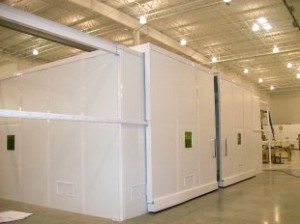Prefabricated Non-Metallic Cleanrooms
Understanding a Cleanroom: A Complete Introduction
A cleanroom is actually a controlled environment where a number of different products are manufactured. Inside of the room, the concentration for any airborne particles is actually controlled to fall within the specified limits. Eliminating all of the sub-micron contamination from the air is all about control. Contaminants are created from facilities, people, equipment and processes. They have to continually be eliminated from the air. The level at which the particles are required to be removed relies entirely upon the standards imposed. Commonly used standards are the Federal Standard 209E. This document establishes standard classifications for air cleanliness from the airborne particle levels within the clean zones and the cleanrooms. Strict procedures and rules need to be adhered to for preventing product contamination. The only means of controlling contamination in the air is to control the overall environment. Direction, pressurization, air flow rate, humidity, temperature and specialized filtration all require tight control. The sources of these airborne particles have to be eliminated or controlled whenever possible. Much more exists in a modular cleanroom mezzanine than just an air filter. Prefabricated non-metallic cleanrooms are manufactured using strict methods and protocols. They are often found in pharmaceutical, electronics, medical device, biopharmaceutical industries, as well as a number of other critical environments. All it takes is a few seconds to monitor the air in cleanrooms compared to an office building to see the difference. Typically, an office building air has anywhere from 500,000 to 1,000,000 particles for every cubic foot of air. A Class 1,000 cleanroom is designed to limit the particles in the air to 1,000 per every cubic foot of air. Considering a single human hair is only 75-100 microns, a particle that is 200 times smaller than that hair can cause significant damage to cleanrooms. Contamination could end up costing the business expensive downtime and an increase in the overall cost of production. NASA’s $1,000,000,000 telescope was damaged and stopped working from a particle that was less than 0.5 microns in size. Once the construction of the room is complete, it has to be maintained and cleaned to the exact same standards as it was from the beginning. Handbooks are provided to alert professional cleaners as to the proper method for cleaning the structure.

Contamination: What Is It?
Contamination is an act or process causing surfaces or materials to become soiled with any number of contaminating substances. Two broad categories exist in surface contaminants: particulates and film type. In a miniature circuit, these contaminants can cause a major defect. Film contaminants amounting to nothing more than 10 nanometers can dramatically reduce the coating adhesion found on chips and wafers. Across the industry, the target is particles of 0.5 microns or larger. Some industries have started targeting particles even smaller than that recently. Any one of multiple contaminants can destroy a circuit. The main objective is to prevent any contaminants from making their way into the cleanrooms. It requires a commitment from everyone who uses the room to make it happen. You want to make sure that professional cleaning crews are aware of the significance in controlling any contaminants. Adhering to strict procedures when entering or cleaning the room is critical. The room cannot be compromised if it is to work properly.
Common Sources of Contamination
Contamination can come in many forms and sizes, all of which can cause a whole host of problems in cleanrooms. Many of the contaminants that filter through the air come from five distinct sources. Facilities, people, fluids, tools and the product that is being produced all contribute to the contamination process. To gain a better understanding of where it is that contamination comes from, consider the following list.

Facilities
- Debris from the air conditioning system
- Construction materials such as saw dust, sheet rock and more
- Coatings and paint
- Floors, ceilings and walls
- Vapors and air in the room
- Leaks and spills
People
- Spittle
- Perfume, cosmetics and other toiletry items
- Oil and skin flakes
- Hair
- Debris from clothing such as fibers, lint and more
Tools
- Particles from normal wear and friction
- Emissions and lubricants
- Vibrations
- Mops, brooms and dusters
Fluids
- Organics, bacteria and moisture
- Particulates that are floating through the air
- Coatings or finishes on the floor
- Chemicals used for cleaning
- Deionized water
- Plasticizers
Generated from Product Manufacturing
- Quartz flakes
- Debris from the cleanrooms themselves
- Aluminum particles
- Silicon chips
If you aren’t sure where to turn for your new room, you can find wall systems for modular cleanrooms available online. Instead of having to worry about the contaminants and pollutants making their way throughout your facility, you can take control and minimize exposure and risk of damage to intricate parts and components. Take the time to check out all of the different options from which you can choose to bring into your business today.
